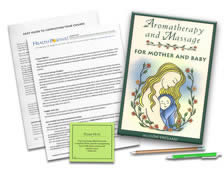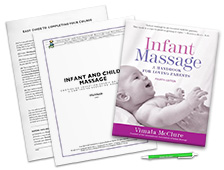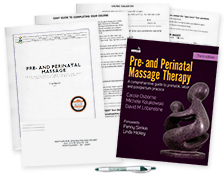

 Want to earn continuing education credit for this article? Learn more.
Want to earn continuing education credit for this article? Learn more.
The challenges of conception, pregnancy, and delivery are supposed to dissipate with the arrival of a new bundle of joy. However, for the parents of an estimated 20 percent of newborns, infant colic can easily hamper that joy. Although a bodyworker may not see babies in their practice, they can indirectly improve a colicky situation. By sharing massage therapy’s colic-easing techniques with a frazzled mom or dad, therapists can help relieve both the baby’s and parent’s discomfort.
About Colic
While all babies cry, some cry far more than others. Despite being healthy, well-fed, and well-cared for, some babies cry inconsolably. Clinically defined as crying over three hours a day, three days a week for more than three weeks in an otherwise healthy baby, infant colic starts a few weeks after birth. Incredibly frustrating, colic generally improves when a baby reaches three months old.
A baby with colic typically exhibits:
- A very loud, inconsolable cry
- A red face
- A tense, hard abdomen
- Drawn-up legs
- Clenched fists
Seeking Help
The signs of colic indicate a distressed baby, a physician must be consulted to rule out a serious problem. A parent should call their baby’s doctor or go to an emergency room, if:
- The baby has not previously been evaluated by a doctor for constant crying for more than three hours or the cries are unusually shrill or intense
- The baby seems to be in pain or acts sick
- The baby’s temperature is over 100.5 º F
- The baby is vomiting or has diarrhea
- The parents are afraid of hurting their baby or feel as if they cannot care for their baby
No one is sure what causes colic, but many experts suspect the following to be contributors:
- Intestinal gas
- Food sensitivity
- Immature nervous system
Luckily, colic is not considered to be harmful to the baby.
Postpartum Depression
Whether it is the release of mood-elevating endorphins, the relaxation state clients enter, or a reduction in stress hormones, many people with depression benefit from massage therapy. Thus, new mothers with postpartum depression often find relief from a nurturing massage session.
While it is no surprise that a colicky infant is especially upsetting for the parents, a Brown Medical School study proved a connection between colicky babies and postpartum depression. Presented in May 2006 at the Pediatric Academic Societies Annual Meeting in San Francisco, researchers estimated that approximately 45 percent of mothers of colicky babies reported moderate to severe depressive symptoms. In addition to directly helping women affected by this kind of depression, massage therapists can also indirectly help the root of the problem. By teaching infant massage techniques for reducing colic, therapists can help stressed-out parents and their babies.
Massage for Colic
Based on the premise that colic is caused by trapped gas, an underdeveloped digestive system, and a highly sensitive nervous system, massage therapy can often help a colicky infant. Using techniques to stimulate the digestive process and calm the nervous system, parents may have more power to help their baby than they previously realized.
Teaching your clients how to massage their babies can be explained verbally or demonstrated on yourself, or even a doll or teddy bear. Several moves are described below:
- Direct Digestive Energy Down – Using a little massage oil or lotion on your hands, place your palm on the infant’s chest, with your fingers pointing towards the child’s shoulder. Next, draw your hand down along the chest, towards their diaper, repeat with your other hand. Repeat with slow, gentle motions. Here it is described as the water fall (sometimes also called paddling):
- Breakup Abdominal Gas – Place the infant’s heel next to the bottom by bending the knee. With the leg still bent, move the thigh towards their stomach until it rests on the abdomen. Slowly and carefully move the legs in a bicycle pattern. Here is another option:
- Move Food and Gas Stagnation – Using as much of your palm and fingers as possible, circle the baby’s belly button in a clockwise motion. Here you can see that demonstrated with some additional techniques:
- Induce Relaxation – Massage the sole of the baby’s feet before bedtime at least 100 times using only the thumbs. Remember to keep the massage at an even and smooth rhythm to help the infant relax. You may even wish to review some reflexology techniques that might be helpful:
Because an infant’s body is much more responsive to touch than an adult’s, only five minutes of massage several times a day is sufficient to strengthen digestion and generate relaxation.
Massage therapists have two ways to help a family with a colicky infant. First, a relaxing massage session for the parent can improve postpartum depression and reduce stress levels. Therapists can also give their clients skills for bringing peace into their homes. By teaching clients with newborns how to massage a baby with colic, therapists can help them reduce their baby’s discomfort. And anyone who has ever had an infant with colic knows it is the most precious gift possible.
Earn continuing education credit for this article contained in our Prenatal & Pediatric Massage series. Click here to enroll.














